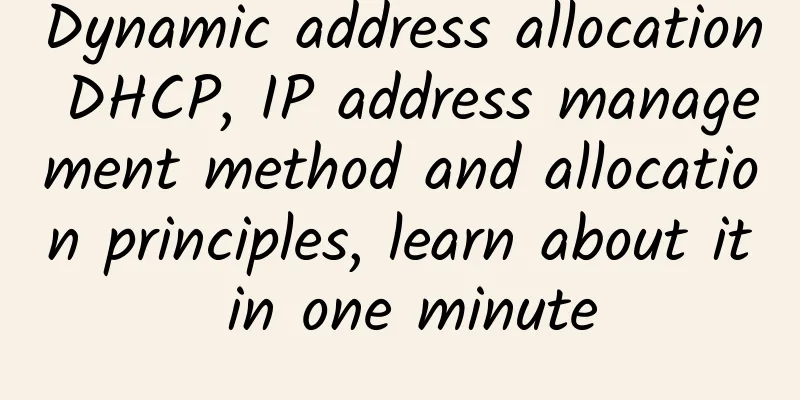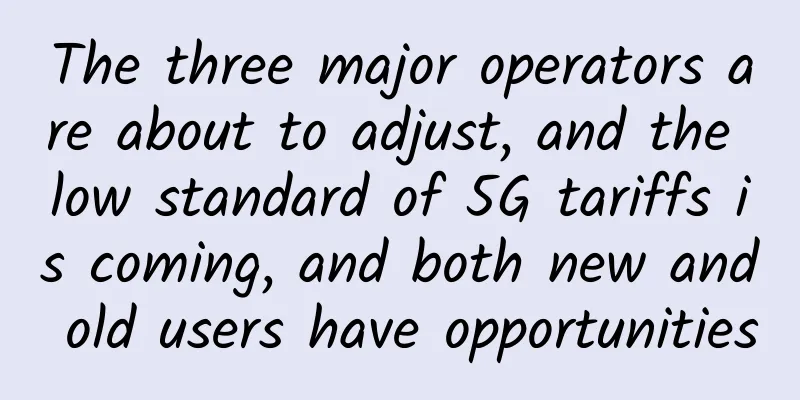Dynamic address allocation DHCP, IP address management method and allocation principles, learn about it in one minute

|
1. Introduction to DHCP DHCP (Dynamic Host Configuration Protocol) is used to dynamically allocate network configuration parameters such as IP addresses to network devices. DHCP uses a client/server communication model, where the client submits an application to the server to request the allocation of network configuration parameters, and the server returns configuration information such as the IP address allocated to the client to achieve dynamic configuration of information such as the IP address. In a typical DHCP application, there is usually a DHCP server and multiple clients (such as PCs and laptops). 2. DHCP IP address allocation 1. IP address allocation strategy In response to different needs of clients, DHCP provides three IP address allocation strategies:
2. IP address acquisition process The DHCP client obtains an IP address from the DHCP server in four stages:
After receiving the DHCP-ACK message from the server, the client will broadcast a free ARP message to detect whether there is a host using the IP address assigned by the server. If no response is received within the specified time, the client will use this address. Otherwise, the client will send a DHCP-DECLINE message to the DHCP server and re-apply for an IP address. If there are multiple DHCP servers in the network, in addition to the server selected by the DHCP client, the IP addresses not allocated this time in other DHCP servers can still be allocated to other clients. 3. IP address lease renewal The IP address assigned by the DHCP server to the client has a certain lease period (except for the automatically assigned IP address), which is called a lease. When the lease expires, the server will reclaim the IP address. If the DHCP client wants to continue using the address, it needs to apply for an extension of the IP address lease. When the IP address lease of the DHCP client reaches about half of the time, the DHCP client will unicast a DHCP-REQUEST message to the DHCP server that assigned the IP address to it to renew the IP lease. If the client can continue to use this IP address, the DHCP server responds with a DHCP-ACK message to inform the DHCP client that a new IP lease has been obtained; if this IP address can no longer be assigned to the client, the DHCP server responds with a DHCP-NAK message to inform the DHCP client that it cannot obtain a new lease. If the renewal operation fails at about half of the lease time, the DHCP client will broadcast a DHCP-REQUEST message to renew the lease when the lease period reaches 7/8. |
<<: G Suite vs. Office 365: Which is the right productivity suite for your business?
>>: Domain name www, to have or not to have, that is the question
Recommend
2022, 6G development continues to heat up
Development of 6G networks is gathering pace, wit...
What exactly is RedCap?
[[431894]] With the continuous advancement of 3GP...
Do you know how wireless networks developed?
MediaTek recently released its flagship 5G mobile...
TCP three-way handshake: in-depth understanding and C# example implementation
In computer network communications, TCP (Transmis...
LOCVPS 20% off, Japan VPS/Korea VPS/Hong Kong VPS/US VPS monthly payment starts from 29.6 yuan
LOCVPS is a long-established Chinese hosting comp...
How private 5G networks can help companies accelerate their transformation to Industry 4.0
With the rise of IoT applications and the increas...
Cisco ASAP helps you to subvert the traditional architecture by starting the full digital transformation of data center
[51CTO.com original article] Enterprise digital t...
What is FlexE in 5G bearer network?
[[413331]] This article is reprinted from the WeC...
Network Basics: How IP and MAC Addresses Work
Both IP addresses and MAC addresses identify devi...
Chrome DevTools: Modify User-Agent and customize personalized UA
[[442534]] This article is reprinted from the WeC...
Omdia: In the third quarter of 2020, 109 commercial 5G networks were launched worldwide
On October 28, according to the latest 5G service...
China Mobile Xiongyan Consulting Insights: 5G URLLC Key Technology Research Report
Labs Guide URLLC "Low Latency High Reliabili...
Ruishu Information opens a new starting point for "dynamic braking" security to identify and block the batch output of information by "legal insiders" in banks
On November 5, 2016, CCTV reported that the Miany...
Operators dig into the Internet of Things: IoT strategic transformation in four steps
Driven by both technology and the market, the IoT...
RackNerd launches new French data center with annual subscription starting at $17.98
RackNerd announced the news of its new French dat...









